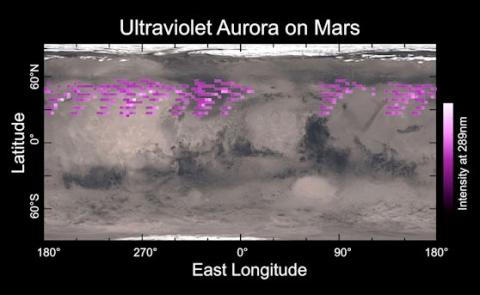Popularly known as Christmas lights, auroras are a special treat by nature that one notices near the Northern (Aurora borealis) or Southern (Aurora australis) hemispheres on Earth. While it was considered some kind of magic in the past, modern science has adequate explanations for the spectators to realize. It is natural for planets with an atmosphere and a magnetic field to have auroras. Scientists have also found the same lights in Saturn and Jupiter other than Earth. However, their appearance on Mars comes off as an astonishment. That is because Mars is known to have lost its global magnetic field. The planet is void of a central atmosphere.
Auroras And Earth
Even though visible at night, auroras are caused by the Sun. The Sun sends us more than heat and light. It also sends small particles charged with energy. The amount of energy is not constant and keeps on fluctuating. Sometimes, these are released as solar winds, while at other times, it takes the form of a solar storm.

As part of a solar storm known as ‘coronal mass ejection,’ the Sun releases a large mass of electrified gas, which can travel through space at high speed. Certain particles from the solar storm travel down through Earth’s magnetic field, lining towards the North and South poles. These, when interacting with the gases present in the atmosphere, result in beautiful lights. Oxygen gives off red and green lights, while Nitrogen glows purple and blue.
Auroras On Mars – And Why Are They Special?
NASA’s MAVEN spacecraft detected auroras in the Northern hemisphere of Mars back in December 2014. The lights did cover a long surface area of the planet, moving around the Martian equator. If it had been Earth, people from Texas and Florida would have been able to see the same.
But Mars is not having a magnetic field like Earth. How was that even possible? To this, researchers have proper answers backing their work. And in the findings, they could spot certain regions of Mars with localized magnetic fields, specifically for the southern hemisphere. These local magnetic fields could interact with the solar winds from space, producing discrete ultraviolet auroras on the Martian ground.

A Planet With A Broken Magnetic Field And Disrupted Atmosphere
There’s evidence that Mars’s magnetic field had decayed quite early in planetary history. Now all it has are patches of magnetism stored in the magnetized crust of the planet. Images from Mars show that auroras are formed near these magnetic fields.
Further, a research team went forward analyzing the data collected by the MAVEN spacecraft in 2014. The team prioritized the conditions of solar winds in deciding the frequency of the lights. They compared the dynamic pressure of the solar winds, the angle and strength of the interplanetary magnetic field, and the ultraviolet radiation of the auroras on Mars. The results showcased how the pressure of the solar winds outside the crustal magnetic field did play an important role in deciding the frequency of the magical lights.
However, when it comes to deciding the brightness of the lights, it is triggered by the mass ejection of the solar particles from the Sun. Also, high levels of wind pressure do act as a trigger in the phenomenon.
Overall, the information collected did play an important role in guiding researchers on the fact that “How a planet stripped of its magnetic field can continue with the auroras?”
Auroras Around The Solar System
As already discussed, Earth is not the only planet getting these auroras. You have the other planetary spaces around the solar system, occasionally getting those magnificent light shows near their poles. Here is a quick glimpse of those.
- Jupiter’s auroras are striking and more intense than Earth’s, owing to the strong magnetic field of the planet, which is 2000 times stronger than Earth’s. A study in 2021 by the Juno spacecraft did release further insights. While so far, astronomers could see the day side of the planet. Now they spotted the nighttime side. There was this bright aurora known as “dawn storms.” The storms produced 100 times more energy than a nuclear reactor on Earth.
- Venus also has striking versions of auroras without posing an atmosphere. However, researchers were able to come to a scientifically proven conclusion. Data collected by the Venus Express spacecraft suggests that some of the magnetic field from the
- Sun gets carried out to the planet along the solar winds. This process leads to the formation of the auroras.
Saturn’s auroras result from the energetic light winds sweeping over the planet. However, these are only visible under ultraviolet lights and require instruments sensitive to ultraviolet radiation for a clear view.
So that s all about the planets and their auroras, especially Mars’s ability to undergo similar light shows without having a steady magnetic field. From the phenomena illustrated above, one can conclude that outer space is incredible, filled with magnificent mysteries, making things more exclusive to study and root upon.



